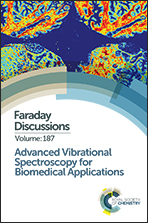FTIR spectroscopic imaging and mapping with correcting lenses for studies of biological cells and tissues
Abstract
Histopathology of tissue samples is used to determine the progression of cancer usually by staining and visual analysis. It is recognised that disease progression from healthy tissue to cancerous is accompanied by spectral signature changes in the mid-infrared range. In this work, FTIR spectroscopic imaging in transmission mode using a focal plane array (96 × 96 pixels) has been applied to the characterisation of Barrett's oesophageal adenocarcinoma. To correct optical aberrations, infrared transparent lenses were used of the same material (CaF2) as the slide on which biopsies were fixed. The lenses acted as an immersion objective, reducing scattering and improving spatial resolution. A novel mapping approach using a sliding lens is presented where spectral images obtained with added lenses are stitched together such that the dataset contained a representative section of the oesophageal tissue. Images were also acquired in transmission mode using high-magnification optics for enhanced spatial resolution, as well as with a germanium micro-ATR objective. The reduction of scattering was assessed using k-means clustering. The same tissue section map, which contained a region of high grade dysplasia, was analysed using hierarchical clustering analysis. A reduction of the trough at 1077 cm−1 in the second derivative spectra was identified as an indicator of high grade dysplasia. In addition, the spatial resolution obtained with the lens using high-magnification optics was assessed by measurements of a sharp interface of polymer laminate, which was also compared with that achieved with micro ATR-FTIR imaging. In transmission mode using the lens, it was determined to be 8.5 μm and using micro-ATR imaging, the resolution was 3 μm for the band at a wavelength of ca. 3 μm. The spatial resolution was also assessed with and without the added lens, in normal and high-magnification modes using a USAF target. Spectroscopic images of cells in transmission mode using two lenses are also presented, which are necessary for correcting chromatic aberration and refraction in both the condenser and objective. The use of lenses is shown to be necessary for obtaining high-quality spectroscopic images of cells in transmission mode and proves the applicability of the pseudo hemisphere approach for this and other microfluidic systems.
- This article is part of the themed collection: Advanced Vibrational Spectroscopy for Biomedical Applications

 Please wait while we load your content...
Please wait while we load your content...